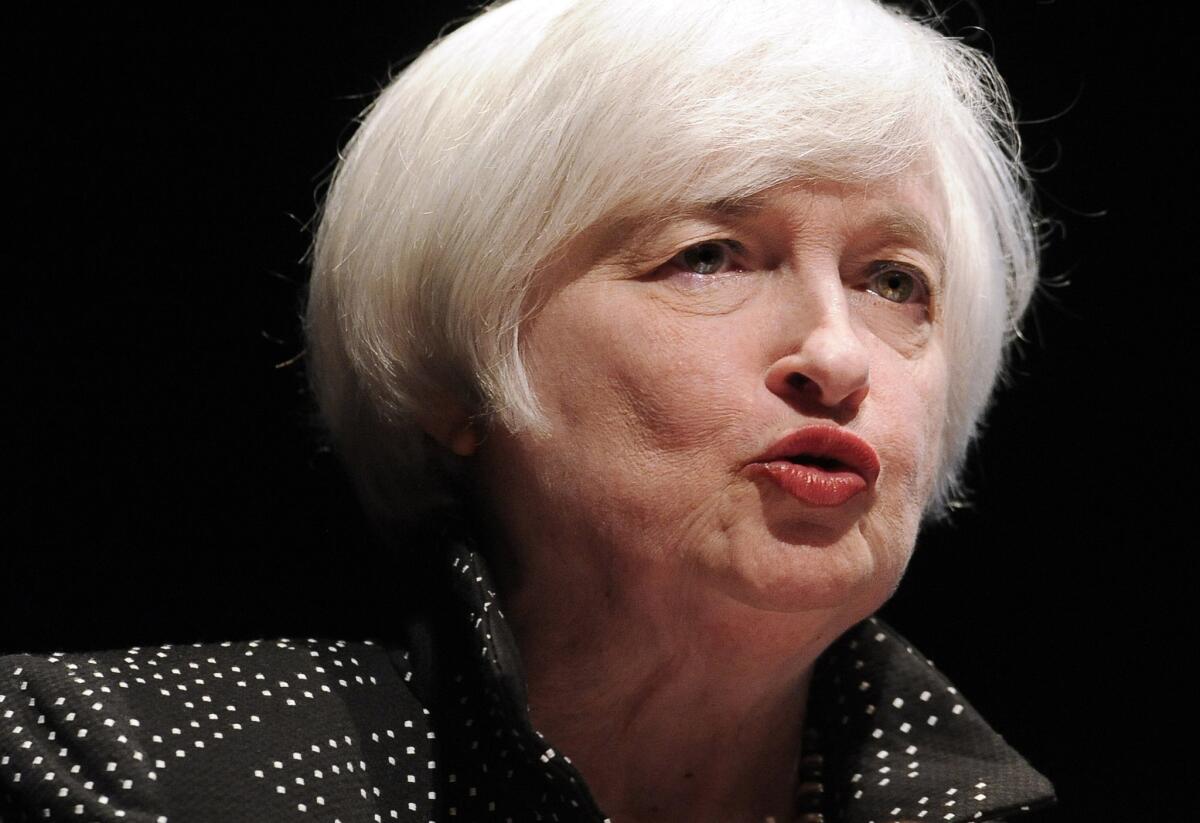Fed holds interest rate steady, but hints a hike could come in December

Federal Reserve Chairwoman Janet L. Yellen speaks at the University of Massachusetts, Amherst, on Sept. 24.
- Share via
Reporting from Washington — Federal Reserve policymakers, concerned that slowing global growth may be hurting the U.S. economy, kept a key interest rate at a historically low level — yet hinted that a hike could come by the end of the year.
In an unusual move, Fed Chairwoman Janet L. Yellen and her colleagues on Wednesday specifically pointed to their next meeting in mid-December as the time when they could enact the first in a series of small rate hikes, as long as the domestic economy continues to improve.
“It seems to me that Janet Yellen is preparing the markets for a rate increase in December,” said Bernard Baumohl, chief global economist at the Economic Outlook Group.
“I don’t recall them actually ever being that explicit by saying something could happen at the next meeting if economic conditions basically continue the way they are now,” he said.
The so-called federal funds rate, a benchmark for consumer and business loans, has been near zero since late 2008 in an attempt to stimulate the economy and pull out of the Great Recession.
Yellen has said she expected the Fed to raise the rate by the end of the year unless there were surprises in the economic data. That was before disappointing job growth in September led to concerns that U.S. economic growth was being hindered by a slowdown in China and other key foreign countries. China’s woes roiled financial markets.
With mounting signs of trouble, two Fed policymakers publicly urged caution two weeks ago and analysts began to doubt whether the Fed would act this year.
Federal Reserve Board Gov. Daniel Tarullo said he didn’t expect a rate hike in 2015, and Gov. Lael Brainard said there was a “case for watching and waiting” before increasing the rate.
But the formal policy statement released after a two-day meeting this week sought to keep the chance of a December rate hike open.
Fed officials approved the statement in a 9-1 vote. Jeffrey Lacker, president of the Federal Reserve Bank of Richmond, Va., dissented because he preferred to raise the rate by 0.25 percentage point, the Fed said.
“I think they effectively reopened the door to December,” said Diane Swonk, chief economist at Mesirow Financial. “The market went too far in writing off December, and the Fed said it’s on the table.”
The Dow Jones industrial average dropped nearly 150 points shortly after the Fed statement was released. But the market recovered, and the index rose 198.09 points, or 1.1%, to close at 17,779.52.
The Fed’s decision not to raise the federal funds rate Wednesday was expected after the lackluster September jobs report and forecasts that third-quarter economic growth was weak. The Commerce Department is expected to report Thursday that the economy expanded at a 1.7% annual rate, less than half the solid 3.9% pace of the second quarter.
Though Fed officials said they were still monitoring global economic and financial developments, their statement indicated less concern about spillover effects in the U.S. than last month’s.
In September, after China’s devaluation of its currency triggered worldwide turmoil in financial markets, Fed policymakers said they were worried that problems in the global economy and stock markets could “restrain economic activity” and add to downward pressures on inflation.
That language was missing from the Fed’s latest statement. And though Fed officials noted that “the pace of job gains slowed” in September, there was a more upbeat assessment of other economic indicators.
Policymakers said household spending and a measure of business investment have been increasing “at solid rates in recent months.”
“In September it was simply increasing moderately,” Baumohl said. “That tells us that there’s a perception at the Fed that the fundamentals of the U.S. economy are strong.”
Inflation remains well below the Fed’s annual target of 2%. But Fed policymakers said the low inflation partly reflected declines in energy prices and in prices of imports. The strong dollar also has hurt U.S. exports, the Fed said.
The next two reports on job growth — for October and November — will be key to the Fed’s decision about whether to raise the rate in December. The last time the rate was raised was in 2006.
Ian Shepherdson, chief economist at Pantheon Macroeconomics, said a December rate hike “hinges on the next two employment reports.” If job creation, wage growth and the unemployment rate signal continued improvement in the labor market, that should be enough for the Fed to raise the rate, he said.
But he stressed, “it’s not a done deal.”
More to Read
Inside the business of entertainment
The Wide Shot brings you news, analysis and insights on everything from streaming wars to production — and what it all means for the future.
You may occasionally receive promotional content from the Los Angeles Times.











